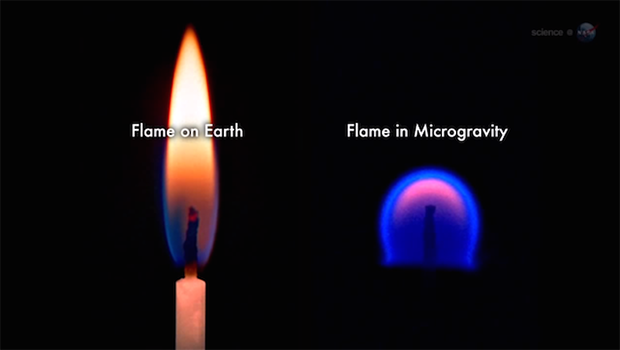"Cool-burning" space flames could help create greener cars
Astronauts typically try to avoid starting fires in space, but new research on the behavior of flames in orbit could have benefits closer to home. In fact, this fiery research could lead to more-efficient car engines that contribute less pollution to the environment, according to a new study.
A series of experiments aboard the orbiting complex is investigating "cool-burning" flames in space -- a type of fire that burns at lower temperatures than ordinary flames on Earth. Blazes on this planet typically burn at between 2,240 degrees and 3,140 degrees Fahrenheit (1,225 degrees and 1,725 degrees Celsius). Cooler flames produced in microgravity burn at temperatures of between 440 degrees and 980 degrees Fahrenheit (227 degrees and 527 degrees Celsius).
In the space station experiments, researchers ignited droplets of heptane fuel. These types of fires are possible on Earth, but they are typically short-lived, flickering out almost immediately, the researchers said. In microgravity, though, the flames burned for several minutes. [7 Everyday Things that Happen Strangely In Space]
"Things can happen out there that can't happen here," lead researcher Forman Williams, a mechanical and aerospace engineer at the University of California, San Diego, said in a statement. "We observed something that we didn't think could exist."
The flame experiments were ignited remotely inside the Combustion Integrated Rack facility, which was installed within the space station's Destiny module in 2008.
The researchers lit droplets of heptane fuel in the facility's Multiuser Droplet Combustion Apparatus and discovered, through sensors, that the droplets continued burning even after they appeared extinguished to the naked eye.
Scientists believe that these droplets can flame on because of a fundamental difference in buoyancy on Earth and in space. Because there is no buoyancy aboard the space station, gases can linger around the droplets longer, allowing elementary chemical reactions to happen. On Earth, buoyancy causes these gases to dissipate too quickly for the process to occur, the scientists said.
The researchers found that heptane burned in several different types of environments, including air similar to Earth's atmosphere, and other types of atmospheres with mixtures of nitrogen, carbon dioxide and helium. These flames create toxic byproducts, such as carbon monoxide and formaldehyde, which eventually burn off.
If this flame chemistry works on Earth, researchers said it could be used to improve internal combustion engines for cars. Burning fuel at cooler temperatures would emit fewer harmful pollutants into the atmosphere, including nitrogen dioxide, nitric oxide and soot.
But successfully getting these fires to burn consistently on Earth will be the next obstacle, the researchers said. To begin tackling that project, scientists plan to study flames produced from different combinations of fuel on the space station for about a year, starting this winter.
The new findings were published in June in the journal Microgravity Science and Technology.
Follow Elizabeth Howell @howellspace, or Live Science on Twitter @livescience. We're also on Facebook & Google+. Original article on Live Science.
- World's Most Extreme Laboratories
- Hyperloop, Jetpacks & More: 9 Futuristic Transit Ideas
- Top 10 Craziest Environmental Ideas
Copyright 2014 LiveScience, a TechMediaNetwork company. All rights reserved. This material may not be published, broadcast, rewritten or redistributed.
